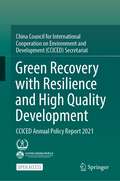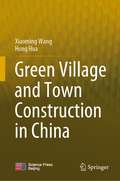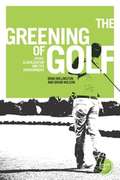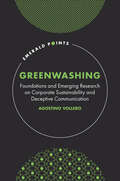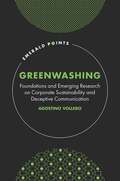- Table View
- List View
Green Recovery with Resilience and High Quality Development: CCICED Annual Policy Report 2021
by CCICEDThis open access book is based on the research outputs of China Council for International Cooperation on Environment and Development (CCICED) in 2021. It covers major topics of Chinese and international attention regarding green development, such as climate, biodiversity, ocean, BRI, urbanization, sustainable production and consumption, technology, finance, value chain, and related topics. It also reviews the progress of China‘s environmental and development policies and the impacts from CCICED. This is a highly informative and carefully presented book, providing insight for policy makers in environmental issues.
The Green Six Sigma Handbook: A Complete Guide for Lean Six Sigma Practitioners and Managers
by Ron BasuThis book is a hands-on single-source reference of tools, techniques, and processes integrating both Lean and Six Sigma. This comprehensive handbook provides up-to-date guidance on how to use these tools and processes in different settings, such as start-up companies and stalled projects, as well as establish enterprises where the ongoing drive is to improve processes, profitability, and long-term growth. It contains the "hard" Six Sigma approach as well as the flexible approach of FIT SIGMA, which is adaptable to manufacturing and service industries and also public sector organisations. You will also discover how climate change initiatives can be accelerated to sustainable outcomes by the holistic approach of Green Six Sigma. The book is about what we can do now with leadership, training, and teamwork in every sphere of our businesses. Lean, originally developed by Toyota, is a set of processes and tools aimed at minimising wastes. Six Sigma provides a set of data-driven techniques to minimise defects and improve processes. Integrating these two approaches provides a comprehensive and proven approach that can transform an organisation. To make change happen, we need both digital tools and analog approaches. We know that there has been a continuous push to generate newer approaches to operational excellence, such as Total Quality Management, Six Sigma, Lean Sigma, Lean Six Sigma, and FIT SIGMA. It is vital that we harness all our tools and resources to regenerate the economy after the Covid-19 pandemic and make climate change initiatives successful for the survival of our planet. Six Sigma and its hybrids (e.g., Lean Six Sigma) should also play a significant part. Over the last three decades, operational performance levels of both public sector and private sector organisations improved significantly and Lean Six Sigma has also acted as a powerful change agent. We urgently need an updated version of these tools and approaches. The Green Six Sigma Handbook not only applies appropriate Lean and Six Sigma tools and approaches, fitness for the purpose, but it aims at sustainable changes. This goal of sustainability is a stable bridge between Lean Six Sigma and climate change initiatives. Hence, when the tools and approaches of Lean Six Sigma are focused and adapted primarily to climate change demands, we get Green Six Sigma.
The Green Six Sigma Handbook: A Complete Guide for Lean Six Sigma Practitioners and Managers
by Ron BasuThis book is a hands-on single-source reference of tools, techniques, and processes integrating both Lean and Six Sigma. This comprehensive handbook provides up-to-date guidance on how to use these tools and processes in different settings, such as start-up companies and stalled projects, as well as establish enterprises where the ongoing drive is to improve processes, profitability, and long-term growth. It contains the "hard" Six Sigma approach as well as the flexible approach of FIT SIGMA, which is adaptable to manufacturing and service industries and also public sector organisations. You will also discover how climate change initiatives can be accelerated to sustainable outcomes by the holistic approach of Green Six Sigma. The book is about what we can do now with leadership, training, and teamwork in every sphere of our businesses. Lean, originally developed by Toyota, is a set of processes and tools aimed at minimising wastes. Six Sigma provides a set of data-driven techniques to minimise defects and improve processes. Integrating these two approaches provides a comprehensive and proven approach that can transform an organisation. To make change happen, we need both digital tools and analog approaches. We know that there has been a continuous push to generate newer approaches to operational excellence, such as Total Quality Management, Six Sigma, Lean Sigma, Lean Six Sigma, and FIT SIGMA. It is vital that we harness all our tools and resources to regenerate the economy after the Covid-19 pandemic and make climate change initiatives successful for the survival of our planet. Six Sigma and its hybrids (e.g., Lean Six Sigma) should also play a significant part. Over the last three decades, operational performance levels of both public sector and private sector organisations improved significantly and Lean Six Sigma has also acted as a powerful change agent. We urgently need an updated version of these tools and approaches. The Green Six Sigma Handbook not only applies appropriate Lean and Six Sigma tools and approaches, fitness for the purpose, but it aims at sustainable changes. This goal of sustainability is a stable bridge between Lean Six Sigma and climate change initiatives. Hence, when the tools and approaches of Lean Six Sigma are focused and adapted primarily to climate change demands, we get Green Six Sigma.
Green Social Work: From Environmental Crises to Environmental Justice (Routledge International Handbooks Ser.)
by Lena DominelliSocial work is the profession that claims to intervene to enhance people's well-being. However, social workers have played a low-key role in environmental issues that increasingly impact on people's well-being, both locally and globally. This compelling new contribution confronts this topic head-on, examining environmental issues from a social work perspective. Lena Dominelli draws attention to the important voice of practitioners working on the ground in the aftermath of environmental disasters, whether these are caused by climate change, industrial accidents or human conflict. The author explores the concept of ‘green social work' and its role in using environmental crises to address poverty and other forms of structural inequalities, to obtain more equitable allocations of limited natural resources and to tackle global socio-political forces that have a damaging impact upon the quality of life of poor and marginalized populations at local levels. The resolution of these matters is linked to community initiatives that social workers can engage in to ensure that the quality of life of poor people can be enhanced without costing the Earth. This important book will appeal to those in the fields of social work, social policy, sociology and human geography. It powerfully reveals how environmental issues are an integral part of social work's remit if it is to retain its currency in the modern world and emphasize its relevance to the social issues that societies have to resolve in the twenty-first century.
Green Up!: Sustainable Design Solutions for Healthier Work and Living Environments
by Stevie FamulariThere are unique greening solutions and practices that help create a lifestyle shift, improving the health of living and working spaces for its occupants from a personal, business, environmental, and profitable perspective. Short-term and long-term considerations are important elements when moving forward towards healthy practices in lifestyles, choices, and site designs. This book addresses a myriad of greening practices that can be applied to structures in our urban, suburban, and rural cultures. From the loft to the neighborhood, the office spaces to the public spaces, and the schools to the communities, this book outlines how business owners and residents can integrate scale appropriate green solutions into their lifestyles. Green Up!: Sustainable Design Solutions for Healthier Work and Living Environments includes detailed illustrations and photographs to help you understand design opportunities for your space. Stevie Famulari provides unique insights and inspires business owners, residents, and planners to develop their own green understanding and design solutions. Illustrations and photographs of applied greening are included throughout the book to help inspire your own goals and design, and then transform them to reality. The author breaks down the misconceptions of the complexity of sustainability and green practices. Greening is a lifestyle change, and this step-by-step instruction guide lets you know how easy it is to transition to the green side!
Green Up!: Sustainable Design Solutions for Healthier Work and Living Environments
by Stevie FamulariThere are unique greening solutions and practices that help create a lifestyle shift, improving the health of living and working spaces for its occupants from a personal, business, environmental, and profitable perspective. Short-term and long-term considerations are important elements when moving forward towards healthy practices in lifestyles, choices, and site designs. This book addresses a myriad of greening practices that can be applied to structures in our urban, suburban, and rural cultures. From the loft to the neighborhood, the office spaces to the public spaces, and the schools to the communities, this book outlines how business owners and residents can integrate scale appropriate green solutions into their lifestyles. Green Up!: Sustainable Design Solutions for Healthier Work and Living Environments includes detailed illustrations and photographs to help you understand design opportunities for your space. Stevie Famulari provides unique insights and inspires business owners, residents, and planners to develop their own green understanding and design solutions. Illustrations and photographs of applied greening are included throughout the book to help inspire your own goals and design, and then transform them to reality. The author breaks down the misconceptions of the complexity of sustainability and green practices. Greening is a lifestyle change, and this step-by-step instruction guide lets you know how easy it is to transition to the green side!
Green Village and Town Construction in China
by Xiaoming Wang Hong HuaBy means of multidisciplinary research on urban and rural planning, construction engineering, environmental engineering and engineering sociology, this book conducts pioneering research on the construction theory, construction methods, evaluation technology and application of demonstration projects in China’s green villages and towns. The book is divided into three parts and eleven chapters. Part I is about the theory and development of green village and town construction, including the theory and innovation, the evolution and development, the patterns and mechanisms, and the community of green village and town construction. Part II is about the planning and construction methods of green villages and towns, including the plan compilation, the environmental infrastructure construction, and the construction and renovation of green buildings in villages and towns. Part III is about the evaluation of the planning and construction of green villages and towns, including the evaluation of plans, the evaluation of environmental infrastructure construction, the evaluation of green building construction, and the comprehensive evaluation of the planning and construction of green villages and towns. Today, 564 million farmers live in 28,500 towns and 2.452 million villages in China. In 2018 alone, 820 million m2 of new houses were built in rural areas. This proves that China’s green village and town construction has great significance and can provide enlightenment to developing countries and even to the world. The book describes new theories, new perspectives and new methods of green village and town sustainable construction in China for overseas experts and readers.
Greening China’s Urban Governance: Tackling Environmental and Sustainability Challenges (ARI - Springer Asia Series #7)
by Jørgen Delman Yuan Ren Outi Luova Mattias Burell Oscar AlménThis volume examines how urban stakeholders in China – particularly city governments and social actors – tackle China’s urban environmental crisis. The volume’s case studies speak to important interdisciplinary themes such as new tools and instruments of urban green governance, climate change and urban carbon consumption, green justice, digital governance, public participation, social media, social movements, and popular protest. It lays out a unique theoretical framework for examining and discussing urban green governance. The case studies are based on extensive fieldwork that examines governance failures, challenges, and innovations from across China, including the largest cities. They show that numerous policies, experiments, and reforms have been put in place in China – mostly on a pragmatic basis, but also as a result of both strategic policy design, civil participation, and protest. The book highlights how China’s urban governments bring together diverse programmatic building blocks and instruments, from China and elsewhere. Written by experts and researchers from different disciplines at leading universities in China and the Nordic countries in Europe, this volume will be of interest to researchers and students who are interested in Chinese politics, especially urban politics, governance issues, and social movements. Both students and teachers will find the theoretical perspectives and case studies useful in their coursework.The unique green governance perspective makes this a work that is empirically and theoretically interesting for those working with urban political and environmental studies and urbanization worldwide.
Greening Citizenship: Sustainable Development, the State and Ideology
by A. ScerriThe greening of citizenship, the state and ideology has created both opportunities and bottlenecks for progressive political movements. Scerri argues that these are pursuing justice by making holistic demands for: fair distribution and status recognition, adequate representation and effective participation.
The greening of golf: Sport, globalization and the environment
by Brad Millington Brian WilsonGolf is a major global industry. The sport is played by more than 60 million people worldwide and there are more than 32,000 courses in 140 countries across the globe. This book looks at the power relationships in and around golf, examining whether the industry has demonstrated sufficient leadership on environmental matters to be trusted to make weighty decisions with implications for public and environmental health. The first comprehensive study of the varying responses to golf-related environmental issues, it is based on extensive empirical work, including research into historical materials and interviews with stakeholders in golf such as course superintendents, protesters and health professionals. The authors examine golf as a sport and as a global industry, drawing on and contributing to literatures pertaining to environmental sociology, global social movements, institutional change, corporate environmentalism and the sociology of sport.
The greening of golf: Sport, globalization and the environment (PDF)
by Brad Millington Brian WilsonGolf is a major global industry. The sport is played by more than 60 million people worldwide and there are more than 32,000 courses in 140 countries across the globe. This book looks at the power relationships in and around golf, examining whether the industry has demonstrated sufficient leadership on environmental matters to be trusted to make weighty decisions with implications for public and environmental health. The first comprehensive study of the varying responses to golf-related environmental issues, it is based on extensive empirical work, including research into historical materials and interviews with stakeholders in golf such as course superintendents, protesters and health professionals. The authors examine golf as a sport and as a global industry, drawing on and contributing to literatures pertaining to environmental sociology, global social movements, institutional change, corporate environmentalism and the sociology of sport.
Greening Our Cities: A Culmination of Selected Research Papers from the International Conferences on Green Urbanism (GU) – 6th edition and Urban Regeneration and Sustainability (URS) – 2022 (Advances in Science, Technology & Innovation)
by Alessandra Battisti Cristina Piselli Eric J Strauss Etleva Dobjani Saimir KristoThis thought-provoking book takes readers on a captivating journey through the realms of green urbanism, urban regeneration, and urban design, development, and preservation, providing an exploration of innovative approaches to creating sustainable and thriving cities of the future.Discussing the pressing challenges of urban environments, this book offers practical insights for architects, urban planners, researchers, and sustainability enthusiasts. It introduces cutting-edge strategies for sustainable urban mobility, energy-efficient designs, and nature-based solutions implementation while showcasing case studies and comprehensive analyses that shed light on the complexities of urban regeneration. Moreover, this volume uncovers the importance of preserving cultural heritage and its role in shaping vibrant communities. With its informative and engaging narrative, this book equips readers with valuable knowledge to make a positive impact on their urban surroundings. It deepens their understanding of urban challenges and illuminates ways they can contribute to transforming our cities toward a more sustainable and vibrant future.
Greenovation: Urban Leadership on Climate Change
by Joan FitzgeraldCollectively, cities take up a relatively tiny amount of land on the earth, yet emit 72 percent of greenhouse gas emissions. Clearly, cities need to be at the center of any broad effort to reduce climate change. In Greenovation, the eminent urban policy scholar Joan Fitzgerald argues that too many cities are only implementing random acts of greenness that will do little to address the climate crisis. She instead calls for "greenovation"--using the city as a test bed for adopting and perfecting green technologies for more energy--efficient buildings, transportation, and infrastructure more broadly. Further, Fitzgerald contends that while many city mayors cite income inequality as a pressing problem, few cities are connecting climate action and social justice-another aspect of greenovation. Focusing on the biggest producers of greenhouse gases in cities, buildings, energy and transportation, Fitzgerald examines how greenovating cities are reducing emissions overall and lays out an agenda for fostering and implementing urban innovations that can help reverse the path toward irrevocable climate damage. Drawing on interviews with practitioners in more than 20 North American and European cities, she identifies the strategies and policies they are employing and how support from state, provincial and national governments has supported or thwarted their efforts. A uniquely urban-focused appraisal of the economic, political, and social debates that underpin the drive to "go green," Greenovation helps us understand what is arguably the toughest policy problem of our era: the increasing impact of anthropocentric climate change on modern social life.
Greenwashing: Foundations and Emerging Research on Corporate Sustainability and Deceptive Communication (Emerald Points)
by Agostino VolleroGreenwashing is an emerging trend that seeks to overemphasize the sustainability practices by companies to their customers. In a comprehensive analysis of this widespread marketing and corporate communication practice, Agostino Vollero examines the understanding of greenwashing, provides a systematic review of available literature review, and reflects on theoretical approaches and research trends. Additionally explored are specific case studies that offer lessons in avoiding the greenwashing trap and a build a look to the future in this context. Greenwashing: Foundations and Emerging Research on Corporate Sustainability and Deceptive Communication showcases fascinating insights and new perspectives in this field, which will be of great interest to scholars of Management, Marketing Communications, Corporate Communication, Accounting and Business Ethics.
Greenwashing: Foundations and Emerging Research on Corporate Sustainability and Deceptive Communication (Emerald Points)
by Agostino VolleroGreenwashing is an emerging trend that seeks to overemphasize the sustainability practices by companies to their customers. In a comprehensive analysis of this widespread marketing and corporate communication practice, Agostino Vollero examines the understanding of greenwashing, provides a systematic review of available literature review, and reflects on theoretical approaches and research trends. Additionally explored are specific case studies that offer lessons in avoiding the greenwashing trap and a build a look to the future in this context. Greenwashing: Foundations and Emerging Research on Corporate Sustainability and Deceptive Communication showcases fascinating insights and new perspectives in this field, which will be of great interest to scholars of Management, Marketing Communications, Corporate Communication, Accounting and Business Ethics.
Gregorian and Old Roman Eighth-mode Tracts: A Case Study in the Transmission of Western Chant (Routledge Revivals)
by Emma HornbyThis title was first published in 2002: This text uses detailed analysis of the eigth-mode tracts in addressing some of the still unresolved questions of chant scholarship. The first question is that of the nature of the relationship between Old Roman and Gregorian chant, the second, of the relationship between oral and written modes of transmission in the ecclesiastical culture of the Middle Ages. Also, the Middle Ages saw a transition to a culture more dependent on writing. The book investigates the effect this transition had on the way eighth-mode tracts were understood by those who performed and notated them.
Gregorian and Old Roman Eighth-mode Tracts: A Case Study in the Transmission of Western Chant (Routledge Revivals)
by Emma HornbyThis title was first published in 2002: This text uses detailed analysis of the eigth-mode tracts in addressing some of the still unresolved questions of chant scholarship. The first question is that of the nature of the relationship between Old Roman and Gregorian chant, the second, of the relationship between oral and written modes of transmission in the ecclesiastical culture of the Middle Ages. Also, the Middle Ages saw a transition to a culture more dependent on writing. The book investigates the effect this transition had on the way eighth-mode tracts were understood by those who performed and notated them.
Grenfell Tower: Preparedness, Race and Disaster Capitalism
by John PrestonThe Grenfell Tower fire of June 2017 is one of the most tragic political events in British history. This book argues that preparedness for disasters has always been designed in the interests of the State and Capital rather than citizens. This was exemplified by the ‘stay put’ strategy at Grenfell Tower which has historically been used to socially control racialised working class groups in a disaster. ‘Stay put’, where fire safety is compromised along with strategic ambiguity, probabilistically eliminates these groups. Grenfell Tower is a purposive part of ‘Disaster Capitalism’, an asocial racial and class eliminationism, where populations have become unvalorisable and disposable. We have reached a point where even the ruling class are fleeing from the disasters and chaos they have inflicted on the world, retreating to their billionaire bunkers. This timely book will be of interest to sociologists, social theorists and activists in understanding the racialised, classed and capitalist nature of contemporary disasters.
Grenze als Ressource: Die soziale Organisation von Schmuggel am Rande der Europäischen Union
by Bettina BrunsHinleitung Im Dezember 2007 sitze ich in einem Berliner Café. Während des Gesprächs mit 1 der Cafébesitzerin holt diese beiläufig ein Zigarettenpäckchen der Marke „Jin Ling“ hervor. Dabei handelt es sich um in der russischen Exklave Kaliningrad hergestellte Tabakwaren. Die „Jin Ling“ würde sie immer von einem Vietnamesen erwerben, der in einer S-Bahn-Station die Stange für 18 Euro, einzelne Päckchen für zwei Euro verkaufe. Ich erzähle ihr von meiner mehrmonatigen Feldforschung an der Grenze zu Kaliningrad, auf der diese Arbeit beruht, und schildere dabei, wie sich Bewohner der von hoher Arbeitslosigkeit betroffenen grenznahen Gebiete durch den Zigarettenschmuggel von Russland nach Polen auf eigene Rechnung ein wenig Geld dazuverdienen. Das sei ja interessant, meint die Cafébesitzerin. Sie hätte - mer ein schlechtes Gewissen, dass sie durch den Kauf von „Jin Ling“ die organisi- te mafiöse Kriminalität unterstütze. Dass sie durch ihren Zigarettenkauf aber unter Umständen den von Armut bedrohten Menschen an der EU-Außengrenze helfe, auf diese Idee sei sie noch gar nicht gekommen. Diese Begebenheit lässt die Komplexität des heutigen Zigarettenschmuggels erahnen, der sowohl die Europäische Union (EU) als auch angrenzende Staaten umfasst. Waren und Menschen überqueren oft mehrere Staatsgrenzen, bis die Zi- rette von ihrem Fertigungsort zum Konsumenten gelangt. An der weit verzweigten Handelskette verdienen viele Personen in vielen Ländern und in unterschiedlichen Funktionen: Verkäufer, Transporteure, Lageristen, um nur einige von ihnen zu nennen. Letztlich lohnt sich der Kauf von Schmuggelware auch für den End- nehmer, was die Voraussetzung für die Wirtschaftlichkeit des Schmuggels ist.
Grenzen: Theoretische, konzeptionelle und praxisbezogene Fragestellungen zu Grenzen und deren Überschreitungen (RaumFragen: Stadt – Region – Landschaft)
by Martin Heintel Robert Musil Norbert WeixlbaumerDer Band setzt sich mit einem für Planung und Politik sowie räumliche Sozialforschung wichtigen, jedoch wenig beleuchteten Thema auseinander – mit dem Thema der Grenze. Dabei ist der Band auf unterschiedlichen Diskursebenen angesiedelt: einerseits auf einer theoretisch-konzeptionellen Ebene, die sich mit dem Thema der Grenzziehung und Grenzüberschreitung auseinandersetzt. Andererseits wird die Bedeutung von Grenzen für die Planungs- und Handlungspraxis von Akteuren anhand konkreter Beispiele ausgelotet. Das Ziel des Bandes ist eine Reflexion aktueller und tagespolitischer Fragestellungen zum Thema Grenze im räumlichen, wie auch sozialen Kontext. Neben einem Beitrag zur geographischen Theoriebildung des Phänomens Grenze soll auch dessen Rolle als alltäglicher Handlungsrahmen, als Barriere bzw. als durchlässiger Kontext thematisiert werden. Der Inhalt• Theoretische und konzeptionelle Zugänge zu Grenzen• Grenzen und Planungspraxis• Grenzen und HandlungspraxisDie Zielgruppen• Studierende, Wissenschaftler und Interessierte aus den Bereichen Geographie, Soziologie, Geschichte, Politikwissenschaft und Raumplanung• Regionalmanager, Stadt- und RegionalplanerDie HerausgeberProf. Dr. Martin Heintel lehrt am Institut für Geographie und Regionalforschung an der Universität Wien.Dr. Robert Musil ist wissenschaftlicher Mitarbeiter am Institut für Stadt- und Regionalforschung (ÖAW).Prof. Dr. Norbert Weixlbaumer lehrt am Institut für Geographie und Regionalforschung an der Universität Wien.
Grenzen der Akteursfähigkeit: Die Beteiligung „verkörperter Agenten“ an virtuellen Kommunikationsprozessen
by Florian MuhleDie Soziologie hat die Grenzen der Sozialwelt traditionell eng gesteckt. Es gilt ihr als Gewissheit, dass allein Menschen zu sozialen Akteuren werden können. Aufgrund neuerer sozialtheoretischer Ansätze und empirischer Entwicklungen der Technikwissenschaften wird diese Gewissheit in den vergangenen Jahren jedoch herausgefordert und es stellt sich die Frage, ob neben Menschen auch sogenannte "soziale Maschinen" zu sozialen Akteuren werden können. Vor diesem Hintergrund besteht Florian Muhles Ziel darin, anhand sozialtheoretischer und empirischer Studien eine soziologisch reflektierte Antwort auf die Frage nach maschineller Akteursfähigkeit "sozialer" Maschinen zu geben. Dabei versteht sich das Buch als Beitrag zu einer Soziologie des Cyberspace. Es werden sowohl Bezüge zu aktuellen sozialtheoretischen Debatten um die Grenzen der Sozialwelt als auch zu medien- und techniksoziologischen Auseinandersetzungen um Interaktivität und Handlungsträgerschaft von Technik hergestellt.
Grenzen der Bildinterpretation (Wissen, Kommunikation und Gesellschaft)
by Michael R. Müller Jürgen Raab Hans-Georg SoeffnerFür die visuelle Kommunikation und für das bildmedial vermittelte Wissen gilt wie für jegliche menschliche Kommunikation und wie für jedes historisch-gesellschaftliche Wissen: Wer kommuniziert und Wissen hervorbringt, weitergibt und deutet, trifft auf die Dialektik von Wissen und Nichtwissen, von Eindeutigkeit und Mehrdeutigkeit, von Evidenz und Täuschung. Die Beiträge des Bandes erörtern diese komplexen Ambivalenzen des Wissens. Sie stellen sich den spezifischen Herausforderungen der Analyse ikonischer Kommunikation und ikonischen Wissens und sondieren in theologischer, kunsthistorischer, medienwissenschaftlicher und wissenssoziologischer Perspektive die methodologischen Probleme und methodischen Grenzen der Bildinterpretation.
Grenzen der Marktlogik: Die unsichtbare Hand in der ärztlichen Praxis (Forschung Gesellschaft)
by Marianne RychnerMehr Markt und Wettbewerb im Gesundheitswesen, so der Tenor aktueller gesundheitspolitischer Debatten, soll Transparenz schaffen, Kosten senken, Missbräuche verhindern und die Qualität der Leistungen steigern. Marianne Rychner zeigt anhand objektiv-hermeneutischer Materialanalysen, in welcher Weise professionalisierte ärztliche Praxis und die Logik des Marktes in einem Widerspruch zueinander stehen. Dies wird deutlich anhand einer detailgetreuen Rekonstruktion zweier ärztlicher Konsultationen. In der Interaktion zwischen Ärztin und Patient entfaltet sich eine komplexe Handlungslogik. Diese konfrontiert die Autorin mit aktuellen Versuchen, der ärztlichen Praxis den Charakter eines marktkonformen Produkts zu geben.
Grenzen der Medizin: Zur diskursiven Konstruktion medizinischen Wissens über Lebensqualität (Theorie und Praxis der Diskursforschung)
by Thomas SchübelThomas Schübel untersucht die Gründe für die Erfolgsgeschichte des Lebensqualitätsthemas in der Medizin. Diskursanalytisch rekonstruiert er „Lebensqualität“ als Inszenierung von Rationalität angesichts medizinischer Entscheidungen, die rational eigentlich gar nicht mehr getroffen werden können. In der Folge lässt sich die Etablierung des Lebensqualitätsthemas in der Medizin als Immunisierungsstrategie einer um Deutungsmacht ringenden Disziplin interpretieren. Der kritische Blick auf die Begründungsfiguren im medizinischen Lebensqualitätsdiskurs kann auch anderen Praxisfeldern vor Augen führen, wie schwierig es ist, Interventionshandeln mit „Wissenschaft“ zu begründen.
Grenzen der Metropole: New York in der deutschsprachigen Gegenwartsliteratur (Literaturwissenschaft / Kulturwissenschaft)
by Christof HamannAnhand ausgewählter Romane und Reiseberichte über New York analysiert Christof Hamann das Verhältnis zwischen Subjekt und Metropole sowie zwischen Alter und Neuer Welt.
